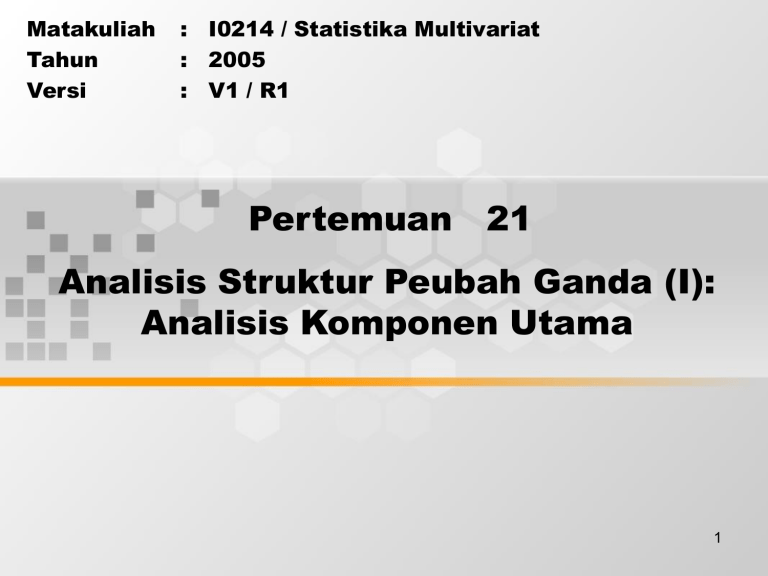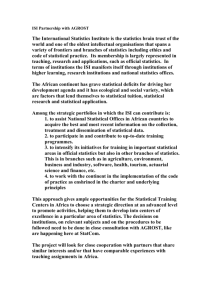Pertemuan 21 Analisis Struktur Peubah Ganda (I): Analisis Komponen Utama

Matakuliah : I0214 / Statistika Multivariat
Tahun : 2005
Versi : V1 / R1
Pertemuan 21
Analisis Struktur Peubah Ganda (I):
Analisis Komponen Utama
1
Learning Outcomes
Pada akhir pertemuan ini, diharapkan mahasiswa akan mampu :
• Mahasiswa dapat menganalisis struktur peubah ganda C4
• Mahasiswa dapat menggunakan analisis komponen utama C3
2
Outline Materi
• Konsep dasar analisis komponen utama
• Analisis komponen utama
3
<<ISI>>
Overview of PCA
One of the major objectives in exploratory data analysis of multivariate data is dimension reduction.
To screen data for obvious outliers.
To select low-dimensional projections of the data for graphing.
To search for “structure” in the data.
The primary statistical tool to accomplish this is through the creation of Principal Components .
A principal component is defined as a linear combination or projection of optimally-weighted observed variables.
(In appearance, this linear function is similar to a multiple regression equation except that there is no intercept term).
4
<<ISI>>
5
<<ISI>>
6
<<ISI>>
7
<<ISI>>
8
<<ISI>>
9
<<ISI>>
10
<<ISI>>
11
<<ISI>>
12
<<ISI>>
13
<<ISI>>
14
<<ISI>>
15
<<ISI>>
16
<<ISI>>
17
<<ISI>>
18
<<ISI>>
19
<<ISI>>
20
<<ISI>>
21
<<ISI>>
PCA Issues
Sample Size
No less than 50 observations, better to have 100. Rule of thumb is to have at least
20 observations per variable.
Measurement Scales
Theory assumes continuous variables. If all variables are binary use correspondence analysis .
Original or Standardized Variables
Principle component analysis can be performed on standardized variables (i.e. assessing the correlation matrix), or unstandardized values (I.e. using the covariance matrix). Standardized scores aid comparisons among different variables, especially when those variables have quite different variances. The difference in variances can be very important in the definition of components.
Number or Variables
PCA can be performed on any number of variables. With large numbers of variables there is a much higher chance that some of the components will have zero or very small eigenvalues indicating exact or near collinearity. Variables that do not weigh highly in the more significant components may be dropped and components 22 recomputed. Removed variables can be analyzed in their own separate analysis.
<<ISI>>
Number of Components to Plot
How many components to plot will depend on the relative values of the eigenvalues and the analysts criteria as to how much of the total variation must be explained. Typical criteria are described below:
• Latent Root Criterion
Plot combinations of components having eigenvalues >1. Use fewer factors if the number of variables is less than 50 and more if the number of variables greater than 50
• Percentage of Variance Criterion
Consider components important until the fraction of explained variance exceeds some pre-specified level, say 95% in the natural sciences or 60% in the social sciences, or when the last component added adds less than 5%
• Scree Test Criterion
Examination of the Scree Plot to identify the number of components where the
23 curve first begins to straighten out
<<ISI>>
24
<<ISI>>
PCA Summary
Principal components analysis is a powerful and useful multivariate technique for reducing the dimensions of data sets with large numbers of continuous variables
Because PCA utilizes only linear combinations, the ordering of the distances between points in p-dimensional space is not changed
Can be used to develop measures capable of representing a number of observed variables (The first couple of components)
There is a high degree of subjectivity in deciding on the number of components to examine and interpretation of those components
PCA is usually applied to the correlation matrix associated with a set of variables (R-mode) or observations (Q-mode). It may also be applied to the covariance matrix of observations that have been centered but not scaled
25
<< CLOSING>>
• Sampai dengan saat ini Anda telah mempelajari kosep dasar analisis komponen utama
• Untuk dapat lebih memahami konsep dasar analisis komponen utama tersebut, cobalah Anda pelajari materi penunjang, website/internet dan mengerjakan latihan
26

